|
Timeline Hypotheses Evidence
Most of this
material is included here on Harpguitars.net, and includes the Knutsen
Patents, the Livermore and Gaskin harp mandolin patents, the
Knutsen/Dyer flyer, the complete BMG advertising run, and the many
instruments themselves, including the critical label information.
Unfortunately, some of the latter data may be faulty due to misread, mis-communicated,
or poorly photographed or inspected labels.
Before attempting
an understanding of the material below, I would
highly recommend reading the Knutsen and Larson books,
re-familiarizing yourself with the
patents,
continuing with the
overview of models,
and then studying the complete
BMG advertising
run.
Next is my
original 2010 list of conflicting or unproven information and
evidence. Happily, some of this has since been solved.
Next is my
original 2010 list of conflicting or unproven information and
evidence. Happily, some of this has since been solved.
A) The Cadenza ad of December, 1901 showing a Type 1
Dyer Symphony harp guitar
B) The various harp guitars of Type 2 design that have
very low serial numbers, along with hard-to-read numbers
C) The mention of a “1906 model” referring to the Type 2
design introduced in December, 1904
D) The handwritten “1909” of Stephen Bennett’s harp
guitar with serial number 669, the claim of a patent on all
post-Knutsen Dyer labels, and Knutsen’s claim of “sole patentee” on
his own labels
E) The unknown date of introduction of the “lower bass
point” harp guitars built by both Knutsen and the Larsons
F) The use of “Style 3” for the Type 3 design, whereas
“Style 4 through 8” are used for ornamentation designations on the
Type 2 design, while Style “1” and “2” have never turned up
G) Duplicate serial numbers
What
follows is my 2010 discussion of the bullets above. I have mostly left
his intact (for archival purposes),
but include new
text in red where I have resolved or changed my opinion.
| A) The 1901
Cadenza ad
This curious ad conundrum was finally put to rest in 2024 when harp
guitarist Randall Sprinkle shared with me a cryptic historic photo which
I tracked down to the Wisconsin Historical Society, who subsequently
licensed it for our use and provided the critical high-resolution image.
You can read the story here.
The reason it proved frustrating for the last dozen-plus years is
discussed below (now redundant, I’m archiving all these discoveries and
updates as they happened, for history’s (and my) sake:
The first
ad that Dyer ran depicting a harp guitar appeared in The Cadenza in
December, 1901. It shows a frustratingly stylized woodcut of a
Knutsen-style (Larson’s Dyer Type 1) Symphony harp guitar. The headstock
appears to represent a clean, slotted, Larson-made headstock, though the
neck itself is offset significantly to the treble side as in a Knutsen.
The depicted 10th fret marker (rather than 9th)
was used by both Knutsen and the Larsons (though not consistently). The
neck heel could be an attempt at depicting either the traditional Larson
heel or the "bulgy" butt-joint heel of early Knutsens like HGT15 and
HGT1. This same ad ran all the way through November, 1904 – with one
curious five-month gap - when it was immediately replaced by a similar
ad with a woodcut of the Type 2 version. Our key questions:
Was Dyer still distributing Knutsen instruments through 1904? Or did
this ad depict the first of the Larson-built, Knutsen-licensed Type 1
instruments? Or yet another possibility – that the ad covered both
Knutsen and, later, Larson instruments? |
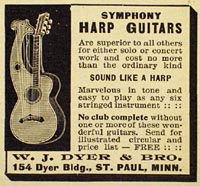
|
|
Bob and I originally agreed that the woodcut
represented a Larson-built Symphony harp guitar.
The artist was presumably copying an actual instrument (or a
picture of one), and the "Waverly-style" tuners on the slotted
headstock seemed a dead giveaway. Knutsen
simply never did this on any known Symphony specimens.
In fact, by 1902, he would permanently switch to a solid
headstock with geared tuners. Moreover, by 1902, Knutsen had
abandoned this model, experimenting with his very inconsistent
“Evolving” Symphony harp guitars for the next few years.
We further interpreted the illustration as depicting a neck heel
– which Knutsen never did, but was typical of Larsons.
The offset neck I attributed to shoddy draftsmanship.
Finally, we had to acknowledge that there are no known specimens
of Knutsen-built instruments with a Dyer label.
And yet….not being able to fit the serial numbers into a timeline
implied by all of the ads, I’ve taken a new, harder look at this
particular ad. |
|
For one thing, rather than ignore the neck placement and
crude neck heel, let’s consider them.
To my eye, the heel looks a
lot closer to the Knutsen bulge – rare, but seen on several early Symphony instruments (see photo)
– than a Larson-style heel (photo).
If we are to take the neck
at face value, then it clearly represents Knutsen’s significantly
offset neck, which is like no other.
On the Larson’s similar Type 1 the neck would be barely offset
to the right (ending up slightly offset to the bass side on the Type
2s). Taking
the headstock and tuners at face value, we clearly see a Larson.
The result: It does not add up.
If we take everything in the drawing literally, we end up with a
chimera of an instrument that does not exist.
So
how do we decipher it?
An alternative scenario that I find perfectly reasonable is that
the engraver copied an image of a Knutsen
harp guitar, and when they got to the difficult-to-resolve mess of
Knutsen’s early headstock – with its crude individual tapered
“slots” - they simply borrowed a design from a more traditional
guitar (virtually any early 6-string image lying around would have
sufficed). This scenario
would then negate the argumentative clue above about Knutsen switching
to a solid headstock, as the ad drawing was completed before that time. If
true, the fact that Dyer didn’t then bother to change the image when
the Larsons finally did produce this model could be explained by the fact that the image
already “looked like” their version.
Both makers had fully bound versions of this design, by the way.
We now know that Dyer was already distributing Knutsen’s own
labeled instruments around 1900, without any apparent qualms – so
there is no real reason to be alarmed by the lack of Dyer-labeled
Knutsens distributed for another couple of years. The
1901 Cadenza ad advertising (Knutsen) “Symphony Harp Guitars” as
being sold by Dyer would not be unusual.
Whatever you (or I) might think of the two scenarios above, let’s
call this a draw for now. |
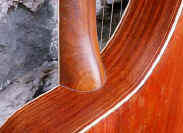
Knutsen
|
|
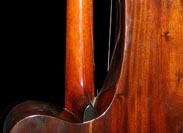
Dyer
|
|
But another problem with this ad is that it ran
for twenty-one consecutive months, then after a
five-month hiatus, returned for another ten months.
That’s a full three years of production for a Dyer model of
which there are only four specimens known! One
caveat about the 5-month interruption: they ran a new ad for
their line of strings for four of these months, so it is
possible, that it wasn't so much a "harp guitar hiatus" as a
"new promotion" of a new product (Sterling Strings). And yet -
it seems more than strange that Knutsen's Symphony harp guitars
from this same period outnumber the Larson Type 1 Symphony by
over 20 to 1, when Knutsen did little or no
advertising. A reasonably logical answer to this dilemma might
be to consider my alternative theory of the previous paragraph –
that the 1901 image was in fact representing a Knutsen
– and that the six-month gap (September, 1903 through February,
1904) possibly coincides with a period where Knutsen was “let
go” and the Larsons were hired and gearing up to copy the
Knutsen model. Knutsen was indeed experimenting with many
different features in 1902 and beyond, and his quality and
aesthetics were only getting worse in general – so Dyer would
have understandably become fed up by this point. It does
seem strange that Dyer would simply re-use the old Knutsen ad
and not roll out a big new campaign, but there is a similar and
even more inexplicable lack of any sense of excitement when they
unveil the Type 2 just nine months later. I thus don’t see
any of this as a deal-breaker in the clue department.
Update, October 2011:
Now that a fourth Type 1 specimen has been found – the first
with a legible Style number (“5” – more on this significance
below), we finally have some better clues. Specifically, that
two of the four known Type 1 serial numbers are now known – 125
and 127 – which we believe equates to the 25th and 27th
instrument built. With the lowest confirmed serial number of the
Type 2 being 140, this would suggest that somewhere between 27
and 39 Type 1’s were produced. Update, March 2020: A fifth Type
1 specimen - the earliest so far - has the Knutsen-signed label
with serial # 120. The Style may again read 5 - in this case, a
small "05." It too has the simple appointments of the Type 2
Style 4.
Bottom line: When taking not only the number of surviving
specimens into account, but also trying to fit the early Dyer
serial numbers into these two opposing scenarios, I find myself
consistently favoring a Knutsen-then-Larson scenario for the
December, 1901 through November, 1904 “Type 1” Cadenza ad. (Just
remember that I could be completely wrong)
Counterpoint:
Bob recently pointed out the question of the Maurer Company
which August Larson bought with other investors in 1900. He
wonders if this could have been a business venture
specifically to be able to handle a new Dyer contract. I
also find this timing intriguing – however I’m not too inclined
to weigh in on it, simply because of my stance above (the low
numbers of instruments found). Nevertheless, this newly-formed
company certainly could have been a key factor in the success of
the Dyer line. Something Bob has never really explored and
shared with us until recently is the fact that the new Maurer
Company might very well have had an unknown quantity of
additional employees to assist in production. They could easily
have employed workers from Maurer’s factory, for example. It is
also not known whether August’s partners (Longworthy and Lewis)
were luthiers or just businessmen. The Larsons were a legendary
“two-man shop” all right – but the key word is “legendary.”
That lore came from Bob’s family members much later, and they
may have known nothing of the early Maurer years. Here is
Bob's latest write-up for us on the Maurer Company:
|
The Dawn of Maurer & Co.
by Robert C. Hartman
Robert Maurer was a music teacher and importer of
musical instruments, the first published notice
being in 1886. The year of 1894 is the probable date
of his first factory production using the firm name
of Maurer Mandolins and Guitars. In 1897 the name
was changed to Maurer & Co. and he produced the
Champion brand of guitars and mandolins, probably
concurrently with some branded Maurer. (I have
recently found “New Model” Maurer branded mandolins
with very early features including a different
shaped peghead (larger, squared-off) than in any of
the later styles
In March of 1900 Maurer sold the company to August
Larson and two investors and/or luthiers for $2,500.
I would think for that tidy sum the purchase would
have included the whole operation of Maurer & Co.
including remaining inventory of instruments. This
statement leads to the possible answer for the very
few circa dated instruments made in those first few
years. It also raises the question, what were their
serial numbers? It is just as possible that my circa
dates for Larson built Maurer instruments should be
earlier.
It is my belief that the brothers built mandolins,
guitars and harp guitars for Regal Mfg. in
Indianapolis during the span from 1901 to 1904,
which would add to their production. These
instruments had their own serial number series so
they did not mingle with the Larson system, which
appears to have started at 101. |
New Bottom Line:
Obviously, Bob won that one! But it took him 14 years and my own
article and conclusions to make it happen!
|
|
B) Type 2 Dyer harp guitars with very low serial numbers and
hard-to-read numbers
It is now clear that the Larsons built the Type 1
harp guitar first, and then created the Type 2, abandoning
Knutsen’s design. That’s not to say that there couldn’t have
been some overlap. So, you would think that as we collected
serial numbers, the Type 1s would be found with very low
numbers, and the Type 2s would generally have higher numbers
than the highest Type 1. If only it were that simple!
One problem that plagues us is indirect evidence. There
are a lot of entries on Bob’s old list (and even some on my
later list) that came from a questionable source. Even when we
know the source, if we don’t see a decent photograph
of the label at the very least, then we are just taking
their word for it. We have long since learned that faded ink or
pencil and/or sloppy handwriting can easily cause a number to be
misread, and even if legible, someone’s hasty scribble and
subsequent letter or email to us of their provenance can yield
errors.
|
Here is an example of difficult to read Dyer labels:
|
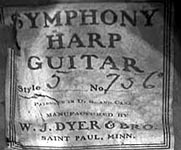 |
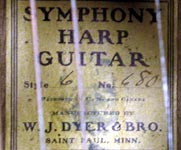 |
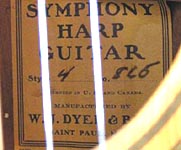 |
|
|
Note the handwritten number 5 and 6 in the series,
starting from the left. Personally, I cannot judge how many of
these serial numbers are in the same hand or penned by different
individuals. The label on the right has been in my folders for
years, but never added to our serial number list. Now I remember
why. I originally couldn't tell if it was "845" or "865." Can
you? I wasn't sure if that was a second poorly-written "4" or
what. I thought the last digit must be a "6." Now that I've seen
many written sixes, I realized that that must be "6," meaning
the last digit can't be another six, but something else -
a "5" with the loop closed (ink bleeding or penmanship). This
is just one example of problematic Dyer labels.
Thus, a serial number that we take in good
faith - but that may actually be a gross error - is
extremely detrimental to our research. For example, #108 is
credited to a Type 2 Dyer that appeared on eBay in the distant
past. We do not have photos from the ad, nor know if any were
even included. We certainly can’t take an eBay seller’s word for
it – from what we now know, the number was almost certainly 608
or 708. As this suspect number might otherwise make or break our
entire timeline and serial number theories, it becomes extremely
problematic – dangerous even. While acknowledging that there is
a real, if very slim, chance that it is correct, we
should certainly make note of it but not use it as
evidence (I long ago removed it from the list for this
reason). Similarly, other Type 2 numbers may or may not
be accurate.
Bottom line:
Help us by submitting clear photographs of your labels. Try
illuminating with a black light in the dark if they are hard to
read.
|
|
C)
The
November, 1906 ad that declares “1906 model” of the Type 2 design
introduced in 1904
|
|
This one makes absolutely no sense. Originally, having seen only
later ads that mentioned the 1906 model, and we assumed it meant
that the Type 2 was introduced in 1906. But we later learned
that the Type 2 appeared in the Cadenza ad of
December, 1904. It arrived with no fanfare, no major
announcement, no special “press release” to the Cadenza editors
that this was a major new design or achievement. Just a similar
crude woodcut and a claim that it was “constructed on an
entirely new principle.” This could be taken different ways
– from a simple advertising boast to an interpretation that it
refers to either the new builders (the Larsons) or the new
design. Note that it also includes the first customer
testimonial, which may or may not have been in reference to
either a Knutsen Symphony or Larson-built Type 1 instrument. |
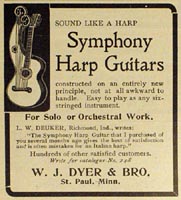
|
|
Then, in November, 1906 – nearly two years later –
Dyer announces the “better than ever” “1906 model.” Yet it
features just a poor resolution copy of the exact same woodcut
from 1904 (along with a total of five testimonials). Again, this
could just be advertising hyperbole (“let’s pretend it’s a new,
updated instrument!”), or it could have some critical,
as-yet-unknown significance to our research. The sixth
sub-bass string wouldn’t show up for another couple years, and
we’ve seen no significant Larson design features from the early
to the later instruments. I honestly can’t think of anything
other than maybe some new construction feature (laminated
bracing experiments, etc.?). Perhaps that is where we should be
looking – a switch in bracing patterns or quality.
Multiple-specimen Dyer repairmen like Kerry Char have long
noticed differences in braces: specifically, Kerry has seen the
X braces in maple rather than spruce, and several have seen the
spruce/rosewood/spruce laminated braces – but we think that that
latter feature coincides with the more expensive Style 7 and 8
and not necessarily dependent on year built. Certainly, more
data is needed. |
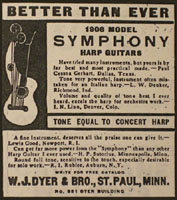
|
|
Curiously, in January, 1907, a Dyer ad appeared in the
American Music Journal, stating "1907 Symphony Harp Guitars"
(Noonan, 2009). I have yet to examine the image, but I suspect
there will be nothing surprising. This new finding makes me
think that they were just updating the "model" with the new year
when the first ads of that year are placed.
Bottom line:
I originally thought this was a tantalizing and unanswerable
clue. Now, with the "1907 model" example on top of the original
"1906 model" example, I would wager that it actually has
no significance. For now, we can ignore it.
|
| D) The
handwritten “1909” on the label of serial number 669 |
|
We get a lot of “provenance” from unverifiable sources. Often it
is a relative who swears that a handed-down instrument was
purchased in some specific year – which usually turns out to be
unlikely or impossible. Other times there are written notes from
a previous owner – either a scrap of paper inside the case or
something added to the label. A simple rule is to consider
this type of information as a possible clue, weighing both its
feasibility and integrity, but to never accept any of it as
“evidence.” Such is the case here. On Dyer harp guitar #669
– once circa dated 1914 in Bob’s system – there is a handwritten
“1909” on the label. As I discuss in an
article on this instrument,
it may or may not have been purchased new, but with all things
considered, has a good 50/50 chance or more of being true. While
it is not verifiable “proof,” I have always thought it was worth
considering, and now take it “on faith.” |
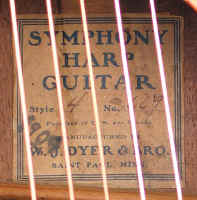
|
|
For it to be true, of course, we would have to A)
discard Bob’s old timeline and, B) come up with a completely new
dating and serial number system that reasonably placed #669 in
1909, while fitting what facts we have. So, to point “A” - we
would first need to determine if there was logically a way to
abandon the current system, which places the theoretical
#601 after February, 1912, when Knutsen’s 14-year 1898 design
patent expired. This logically deduced scenario had been a
“fact” during the entire duration of our decades of research
into Knutsen and the Larsons – adhered to by Bob Hartman, Noe
and Most, and myself. But we never had all the evidence, just
the reasonable logic of the theory. We do have the
findings of Knutsen co-author Tom Noe from his exhaustive search
at the U.S. Patent and Trademark Office, which may (or may not)
have specific bearing on the case – they “prove” some things but
not others. Regardless, I was increasingly frustrated by all the
Knutsen and Dyer provenance that didn’t seem to fit the existing
1912 theory.
So, playing “devil’s advocate,” I first asked
myself if there was a way Dyer could have obtained the rights
to, or ownership of, Knutsen’s 1898 design patent before
it expired in 1912. Unfortunately, the bottom line is, yes,
this could have occurred, but according to Tom Noe,
did not occur – all of which I will explain next
(with good news at the end!).
I posed specific questions to both Tom Noe and
Dyer owner and law professor John Thomas. Their answers were
very illuminating.
Q: Could a 14-year design patent be “renewed” or extended?
TN: Patent terms are not extendible or renewable. 35 USC
154. Trademarks and copyrights can be renewed, but patents
cannot be. When a design patent application is filed, the
patentee selects a term of 3-1/2, 7, or 14 years, and pays an
application fee appropriate to the term selected. Note on the
two Knutsen patents that they state "Term of patent 14 years."
Q: Could two individuals or businesses share this patent?
JT: Yes. The patent holder can license others to use it.
(so “share” only in the sense that both are allowed to market an
item under the contract – but one is a patentee, the other only
a licensee – GM)
TN:
(Since) a licensee does rely on the patent owner to enforce the
patent if an infringement occurs, it would be reasonable for
Dyer to claim that the guitar was protected by a patent.
Q: Would there be a record of the
Dyer license?
TN:
There is no requirement to record licenses. They are basically
contracts.
Q:
Would a patent holder
continue to use old labels on instruments to imply the old
patent is still valid well past the legal period?
JT:
Yes. Beyond the Knutsen and Dyer examples, there have been
others.
TN:
There is no legal requirement to remove "patented" or patent
numbers once the patent expires (this is why we see "C.
Knutsen's Patents" on the New Hawaiian Family label long after
the expiration of the only patents he had). (This) raises the
question of why isn't a patent owner committing fraud by not
taking "Patented" or a patent number off the product. The
answer to that is: #1) saying the product is patented is true
(falsity is an element of fraud), and #2) it would place an
undue burden on a patent owner to recall every product with a
patent number on it.
Q: What about the licensee (Dyer)?
TN: A licensee merely has a right to use (infringe) a patent.
When the patent expires, anyone can use the patent subject
matter. I suppose that Dyer could still say that the design was
patented, but couldn't rely on Knutsen for enforcement purposes.
Q: What does “sole factors” mean on the new September, 1908
Dyer ad?
JT: In this context, I'm confident that "factor" means agent.
From
www.dictionary.com:
5. a person who acts or transacts business for
another; an agent.
6. an agent entrusted with the possession of goods to be
sold in the agent's.
It's not a use that one hears these days, but it crops up in old
business law cases. Dyer & Bro. were advertising that they were
the exclusive agents for selling (this) harp guitar. They used
the plural because the company was "W.J. Dyer & Bro."
TN: Yes, “sole factors” means they were the only agents selling
Dyer guitars.
And the $1,000 question…..
Q: Could a (design) patent be transferred back in 1906?
JT: Yes. From the enactment of the first patent act in 1790,
patents have been considered intellectual property that can be
transferred, licensed, etc.
TN: (Yes, but)
the law requires that
any transfer of patent rights be recorded in the PTO, both in
ownership records and on the file jacket. The transfer of ownership records
don't exist. So, Dyer was a (only a) licensee until 1912…since
Knutsen's patents expired by 1912 (14 years from 1898 on the
second Knutsen design patent), there were no longer any rights
to own.
I pressed Tom on how certain he was, as my whole
“theory” may well have rested on this. He provided further
details of his search and his qualifications for same, and
indeed, the case seems to be closed.
TN: A transfer of ownership of patent rights is known as an
"assignment." The PTO maintains assignment records - drawers
and drawers of them because most patents were assigned to
companies by employee-inventors who had to as a condition of
employment. Even a sale of a patent from one company to another
is an assignment. If a company acquires another company, all
the patents in the acquired company's portfolio have to be
assigned because failure to assign with a period of time results
in an unenforceable patent. If you have a patent number, you
can go to the assignment records and find out who the owner is.
I did that, so I know.
In the last five years of my corporate practice, I was
Intellectual Property Counsel for Danaher Corporation. Among
other duties, I was a member of Danaher's acquisition due
diligence team evaluating patent and trademark portfolios of
target companies to ensure that rights hadn't expired and that
there were no defective assignments. I only mention this
because I spent hours going through assignment records and was
quite proficient at it.
Without an assignment, it is fraud for another, including a
licensee, to claim ownership rights in a patent because it
is a false claim with intent to deceive the public.
So there you have it. It appears that Dyer did
not take over the Knutsen patent prior to its expiration in
1912.
Tom has blown my entire theory…or has he…?
Not at all.
I realized that I was
exploring a “patent transfer theory” not just in hopes of moving
up the 600-series labels (and all Dyer dates) but at the same
time to explain why the “Patented in U.S. & Canada” remained on
Dyer instrument labels so far beyond the 1912 expiration date.
(My “patent extension” question was for this same reason).
Since it felt like a related clue I was focused (and stuck) on
this theory. In any event, based on Tom’s answers above, the
latter question remains unanswerable with specifics, but perhaps
simple overall – Dyer was in a gray area and chose to just
continue using pre-1912 labels that included “Patented.” The
law allows the patentee to do so, a licensee might very well
gamble on the same “scare tactics.” As there is no other
rational or legal explanation, and this did take place,
what other answer is there?
But wait a minute, you’re saying – Dyer didn’t
continue a label in 1912, they switched! (from
the Knutsen-signed label to the standard Dyer label)
Ah hah!
Wrong. They had already switched labels much earlier. Assuming
this is true, wouldn’t it better fit with Tom’s explanation of
patent law above for Dyer to have continued with a pre-existing
label (burden of recalling labeled products, etc.)? As opposed
to fraudulently creating a brand new label in 1912
after the Knutsen patent expired…which again claimed
“patented.”…? Both options involve a gray area of patent
law and marketing, but with the “1912 new label” option
appearing so much less tenable, it (to me) bolsters the idea
that Dyer had to have switched labels earlier.
But how?
I can think of many reasons why Dyer would
have done this, and how most of the clues better fit this
timeline, and even how it all jibes with what we know of
Knutsen. As to how, I simply assumed “Why not? What do
we imagine might have prevented such a simple and obvious
event?” I just needed to make sure that it could have
happened.
So, a final email to Tom Noe, patent expert,
Knutsen expert…
Q: Tom, the final $10,000 question: Is there any reason to
think, or insist, (or have legal basis for) that Knutsen had
to continue to sign the Dyer labels for the full ten or so
years of the license?
I also included for Tom a re-cap of some pertinent
facts:
1.
Knutsen’s applicable patent was in effect from 1898 to Feb 15,
1912.
2.
Dyer licensed this patent from Knutsen starting sometime between
1901 and 1904 (we now know this was
1901)
3.
Dyer printed up labels, which were sent to Knutsen, who signed
them and returned them. These were sent to the Larsons, who
entered serial numbers and installed them in the Dyer
instruments.
4.
All of these labels have serial numbers only in the 100 or 200s.
5.
When Dyer switched to a NEW label
- one without Knutsen's signature - the numbers jumped to 600.
6.
There is no record of Knutsen transferring his patent to Dyer.
Could not the licensing contract simply have been revised so
that Knutsen's signature was not necessary?
TN: There is no legal requirement that Knutsen had to sign
labels, except by contract. Of course, we have no written
contract so we don't know exactly what the arrangement was. But
the fact that the first few labels were notarized tells me that
Knutsen didn't trust Dyer initially, and relaxed a bit as time
went by and subsequent labels were signed but not notarized. It
is really unusual for a licensor to sign labels or products. I
think this was Knutsen's way of keeping track of royalties, at
least at first.
One possibility is that Dyer negotiated a paid-up license
so that the parties didn't have to deal with labels/instruments
on a piece-meal basis. (Regarding the gap between Dyer serial
number series) it could be that Knutsen initially signed 500
labels, 300 of which were returned when some new arrangement was
reached. So Dyer designed a new label, and started with serial
number 601. That’s one scenario.
Bottom line: your theory holds water. By the way, paid-up
patent licenses are quite common. What that means is that for
some agreed-upon royalty figure, the license is paid up for the
term of the patent. It eliminates all the reporting, paying
ongoing royalties, and having the licensor looking over your
shoulder.
And so, once again, there you have it. Understand
that we don’t have proof that such a thing occurred.
But also understand that, similarly, we don’t have any proof
(and little reason to continue to believe) that the
Knutsen-signed label continued all the way up to the expiration
of his patent in 1912.
I don’t know how simple this seems to you, or how
long it has taken you to read, absorb and ponder. It has taken
me years, months, weeks, and now many dozens of hours to rewrite
for the hundredth time – so I know it’s complicated and
convoluted, but I hope the reader considers that I’m on to
something.
Regarding Tom’s interesting speculation above
about the labels jumping in sequence, it might make sense if
these “500 labels” were all serialized, but they weren’t – they
were left blank for the Larsons to fill in. (Update, Sept,
2011: though now I’m wondering that – since the red
pencil/ink of Knutsen’s signature and the Style and Serial
numbers seem to match up, that Knutsen didn’t possibly do all
that himself…?) In any event, I’ve studied American fretted
instrument history long enough to conclude that maker’s serial
numbering systems are often convoluted and arbitrary.
Now, using the above premise, I’ll re-examine the
Knutsen/Dyer timeline.
We know that Knutsen signed the earliest
Larson-built Dyer harp guitars, and that the U.S. and Canada
patent referred to on the label was his (Knutsen’s c.1899 labels
also listed “England”). We can thus safely say that there
was a licensing agreement between Dyer and Knutsen in this
period, which presumably started when Dyer stopped distributing
Knutsen instruments and instead commissioned the Larsons to
build a better version. This must have been in either
mid-to-late1901, as evidenced by the Emory Bennett photo
discovery.
At this point, with the Larsons building
substantially more professional instruments, what if Dyer wanted
to completely distance himself from Knutsen, whose name was
still on the labels? Might not Dyer’s customer get the
impression that Knutsen built their instrument since he signed
it? Dyer would never subsequently credit the deserving Larsons
for their work – wouldn’t he have been even more reluctant to
have Knutsen’s name on the label?! Remember that this would
have been going on for a full ten-plus years during the height
of Dyer’s Cadenza ad campaign.
As stated above, I find it much more likely that
Dyer convinced Knutsen (with financial incentive or otherwise)
to re-negotiate their licensing contract. If such an event
occurred, it would not take effect until mid or late 1906 at the
earliest, and mid-1908 at the latest
(Note: I’ve now placed the specific Dyer events at mid-1908),
and here is what would have theoretically happened:
Knutsen would
stop signing Dyer labels and the new Dyer labels would be
issued.
The “600” series
of serial numbers for harp guitars would begin
(this almost certainly coincided with the label change).
Knutsen would
stop using “Symphony” on his labels, while Dyer continued
using it (this is a known fact, with an
approximate date of this very period. Specifically, circa 1906
he went from “Sole Patentee of the Symphony Harp Guitar with 11
Strings” to “Sole Patentee of the Harp Guitar with 11 Strings.
The theoretical reason being that Knutsen has now
licensed the exclusive use of the “Symphony” name to Dyer.
Knutsen would
still claim “Sole Patentee” on his labels
and Dyer would claim “Patented
in the U.S. & Canada” (these are both facts: for Knutsen,
the approximate dates of 1906/1907 through 1913/1914 for this
label feature are fairly accurate, while the Dyer date is the
unknown.
Knutsen would
begin making only his “lower bass point” (a pointed
flare on the lower bass bout) and “double point” harp guitars
(this is a fact, with an approximate date of this very period).
Many of these would be shorter ¾ scale instruments.
The Larsons
would also build a “lower bass point” harp guitar with a short
scale.
I had dubbed this a “Type 3” Dyer, and by complete coincidence
it was also labeled a “Style 3.” It was built right at the
start of the label change, as every specimen found with a label
has a serial number in the very low 600’s (this is a fact,
though the date of this label change is unknown,
though I have now moved it to mid-1908).
It is not known who copied who on this design
(presumably the Larsons copied Knutsen),
but it is clear that Knutsen built them from circa 1906/7 to
1913/1914, but not beyond, and that the Dyer version appears to
have been only made for a very short time coinciding with the
low 600 serial numbers.
Dyer would state
“Sole Factors” on their ads beginning in September, 1908
(this is a known fact. However, I no longer think it relates to
the new license or new exclusivity of the “Symphony” term
[though it may]. It more likely means that Dyer was merely the
“sole agent” for selling Dyer harp guitars.
Dyer would also
introduce a harp mandolin (this is a fact –
once believed to have occurred in the fall of 1908, but now known to
have occurred in late 1907).
OK, so are there any logistical problems with any of these eight
theoretical events?
No. Bullet #4 is fully covered by Tom Noe’s
answers above. I was always stumped by this issue: How could
both Knutsen and Dyer claim that their harp guitar was
protected by the patent at the same time – with Knutsen even
claiming “sole patentee”? As Tom explained, Knutsen
was still the "sole patentee" – he never transferred it, so
remained the sole owner of the patent for its fourteen-year
duration - and Dyer was still a licensee, allowed to claim
patent protection for their licensed product – with or without a
signature from the licensor. As far as public perception,
Dyer’s customers would now no longer be aware of this "Knutsen
person" from the label – in fact, the new label “implies” that
Dyer owns the patent. Nor would the public find any other
maker’s harp guitar labeled “Symphony” from here on out. I can
certainly see Dyer pushing for such a deal, and Knutsen might
have stopped worrying or caring after a while - especially if
they sweetened the licensing fee.
None of this quite explains the “patent” inclusion
on the Dyer label after 1912. In fact, Dyer never removed
the patent notice from their labels. It is still there on the
highest serial number we have a photographed label from. This
instrument is circa dated at 1922 in the old system, and in any
of my new timelines, still approaches 1920. How did they get
away with it? Well, as Tom explained, a patent holder was
allowed by law to leave a patent notice on a product even after
its patent had expired – and Knutsen himself did so, stating
“Knutsen’s Patents” on the post-1912 “New Hawaiian Family”
labels (which included a photo of an older harp guitar). Dyer
must have followed suit, although they were in a much shakier
gray area. A final frustrating fact is that Dyer included the
“Patented in U.S. & Canada” on the labels of the very first
to very last harp mandolins, even using them even on the
later (brand new) mandolas and mandocellos. Tom Noe has no
answer for this one, it seems to be a completely fraudulent
claim.
Bottom line: We have two very different options here, one of
which requires a paradigm shift. Neither is yet 100% provable.
Either the new 600 series Dyer label appeared in February, 1912
(as originally published by Bob Hartman), or it appeared in the
1906 to 1908 timeframe. I favor the earlier timeline, and,
after my latest serial number
statistical number crunching, have decided on mid-1908.
|
|
E) The “lower bass point” harp guitars built by both Knutsen
and the Larsons
|
|
A key question for both Knutsen and Dyer/Larson fans is
of course “who influenced who” – did Knutsen come up
with this distinctive design, or did the Larsons?
If we consider the full 1906-1908 timeframe for
the label / 600-series switchover, then things are
cloudy, as it would depend on how accurately we could
pinpoint both Knutsen’s first instrument of this type
and the exact date of Dyer’s new license / label /
600-series. However, again,
after number crunching, I found myself choosing mid-1908
for these events. |
 |
 |
|
|
Bottom line: I still have no proof, only a strong “gut
feeling” that Knutsen created this model, then the double-point
sometime in 1906, and that the Larsons briefly “copied” his
“lower bass point” design around the
middle of 1908.
|
|
F) The strange case of the “Style 3” |
|
In the previous version of this article (June,
2011), this was an extremely lengthy and troublesome
discussion of how in the world Dyer’s “Style 3”
appears to have occurred a few years after the Style
4 through 8. As it is something Bob Hartman and I
thought long and hard on, I have
archived it here.
However, since the discovery of Type 1 specimens
#120 and #125, I think we may be over-analyzing it.
|
 |
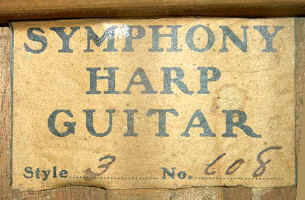 |
|
|
The answer may be simply this: The specimen #125
(refer to my
Gregg’s Blogg article) finally
showed us that the label’s Style number did not include a
“U” or a “0” which we thought we were seeing on the identical
specimen 127. Instead, both turn out to be a Style 5.
Curiously, the plain appointments match the later Type 2’s
Style 4, not its Style 5 with top binding. But so what?
Obviously, Dyer/Larsons made a switch – a new ornamentation
designation system – when they brought out the Type 2.
My guess? Simply that when the first Type 1’s were
built for Dyer (beginning with the theoretical serial #101),
someone chose a simple numbering system that arbitrarily
assigned “5” as the lowest style number. Maybe it seemed like a
nice round number, who knows? Remember that they were just
getting started and probably hadn’t yet come up with the
specifics on how many “models” (of ornamentation) they might do.
As two of the four known Type 1 instruments match the later
Style 7 ornamentation, we know that there were at least two
“models/styles” (again, just using the original Knutsen Symphony
form).
A couple years, later, by the time the Type 2 was
designed, they had probably come up with the idea of their four
(then five) different “Styles.” For whatever reason, “4 was the
new 5” (to use a modern expression). Style 4 was now the
plain model, and there was nothing below it. And they were
off and running.
When they later decided to do the new “Seattle
Knutsen”-like, short scale instrument, they had a dilemma. This
was not a new “style” of ornamentation on the same
instrument; it was a whole new body style “model.” But,
for whatever reason (ability to just use the same labels?), they
simply assigned this new shape (which itself
occurred in a couple levels of ornamentation) its own “Style”
number. They could have picked anything – “3,””1,” even a word
like “Terz,” whatever. But they chose “3” which happened
to be adjacent to their existing lowest number.
Update, January, 2012:
The latest (sixth) Style 3 found (#610) is in the family of the
original owner, and family lore says it was purchased "about
1909." Accurate or not, that is
certainly close to my new proposed date of mid-1908!
Update, January, 2013:
A seventh Style 3 has long been hiding right under our noses,
owned by the late Bob Brozman. Curiously, it has a
somewhat later serial number: 673 (not a hard to read "613" but
definitely a "7" according to Bob. Without being able to see it,
I suggest that it is in fact "613".)
Bottom line: This is my current theory. As far as why they
chose “3,” who knows (or cares)? The dating, the timeline –
none of it matters for this discussion. We just have to accept
that we were fooled by an apparent “sequence” – Bob and I were
looking at “3, 4, 5, 6, 7, 8” and stuck thinking
“consecutively,” wondering where Styles 1 and 2 were! Problem
solved…(?)
|
|
G) Duplicate serial numbers |
|
We now know that harp mandolins duplicated the same sequence as
harp guitars, but several years later. Just a couple of these
duplications are known. We also have long had many reports of
duplicate numbers; however, the majority of these are still
unverified (see bullet B above). However, we now know that
mistakes do happen and that there are Type 2 Dyer harp
guitars with the same serial number, with two
distinct legible handwritten labels. Three examples appear in my
serial list above (denoted with “(2)”).
Bottom line:
Please continue to photograph and submit your labels for
verification!
|
|